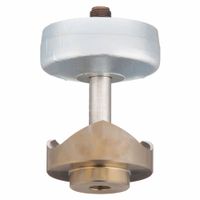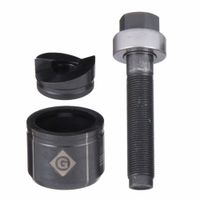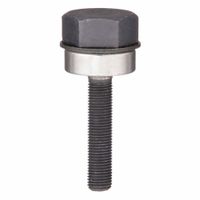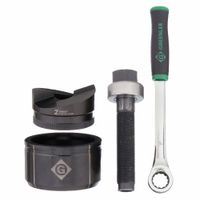Call +(254) 703 030 000 / 751 483 999 / 721 704 777
- Home
- Tools
- Hand Tools
- Punching Tools Chisels
- Knockout Punches Dies
.....Read More
Frequently Asked Questions
What is a knockout punch and die set used for?
A knockout punch and die set is a tool used primarily in metalworking and electrical applications to create clean, precise holes in sheet metal, plastic, or other materials. The set typically consists of a punch, a die, and a draw stud. The punch is the cutting component, while the die provides a matching hole for the punch to pass through, and the draw stud is used to apply the necessary force.
The process begins by drilling a pilot hole in the material where the knockout punch will be used. The draw stud is inserted through this hole, with the die placed on one side of the material and the punch on the other. By tightening the draw stud, usually with a wrench or hydraulic driver, the punch is pulled through the material and into the die, cutting out a clean, round hole.
Knockout punch and die sets are commonly used by electricians to create holes in electrical panels, junction boxes, and enclosures for installing conduit and fittings. They are also used in HVAC, plumbing, and automotive industries for similar purposes. The sets come in various sizes to accommodate different hole diameters and material thicknesses.
The advantages of using a knockout punch and die set include the ability to produce precise, burr-free holes quickly and efficiently, reducing the need for additional finishing work. This tool is especially valuable in situations where accuracy and a clean finish are critical, such as in the installation of electrical components or in custom metal fabrication projects.
How do you use a knockout punch and die?
To use a knockout punch and die, follow these steps:
1. **Select the Right Size**: Choose a punch and die set that matches the size of the hole you need to create.
2. **Prepare the Material**: Mark the center of the hole on the material using a center punch to create a small indentation. This helps in aligning the punch accurately.
3. **Drill a Pilot Hole**: Use a drill to create a pilot hole at the marked center. The hole should be slightly larger than the draw bolt of the punch set.
4. **Assemble the Punch and Die**: Insert the draw bolt through the die and then through the pilot hole from one side of the material. Attach the punch on the opposite side, threading it onto the draw bolt.
5. **Tighten the Assembly**: Use a wrench or ratchet to tighten the draw bolt. As you tighten, the punch is pulled through the material, cutting out the desired hole.
6. **Remove the Punch and Die**: Once the hole is cut, unscrew the draw bolt to separate the punch and die from the material.
7. **Clean Up**: Remove any burrs or sharp edges around the hole using a deburring tool or sandpaper for a smooth finish.
8. **Inspect the Hole**: Ensure the hole is clean and meets the required specifications.
This method is commonly used in electrical, plumbing, and metalworking applications to create precise holes in sheet metal or other materials.
What sizes do knockout punches and dies come in?
Knockout punches and dies come in a variety of sizes to accommodate different applications and materials. The sizes typically range from small diameters, such as 1/2 inch, to larger diameters, like 4 inches or more. Standard sizes often include 1/2 inch, 3/4 inch, 1 inch, 1 1/4 inch, 1 1/2 inch, 2 inches, 2 1/2 inches, 3 inches, and 4 inches. These sizes are commonly used in electrical, plumbing, and construction industries for creating holes in metal sheets, electrical panels, and other materials.
In addition to standard sizes, knockout punches and dies can also be custom-made to fit specific requirements. The size of the punch and die set needed depends on the thickness and type of material being punched, as well as the desired hole size. Some sets are adjustable or come with multiple interchangeable dies to provide versatility for different projects.
For conduit and pipe applications, knockout punches and dies are often sized to match the outer diameter of the conduit or pipe, ensuring a snug fit. For example, a 3/4-inch conduit would typically require a 1 1/8-inch knockout punch to accommodate the conduit’s outer diameter.
Manufacturers may offer metric sizes as well, catering to international standards and applications. It's important to select the appropriate size and type of knockout punch and die to ensure clean, precise holes and to avoid damaging the material or the tool itself.
How do you maintain knockout punches and dies?
To maintain knockout punches and dies, follow these steps:
1. **Regular Cleaning**: After each use, clean the punches and dies to remove any debris, oil, or residue. Use a soft brush or cloth and appropriate cleaning agents to prevent corrosion.
2. **Inspection**: Frequently inspect for wear, cracks, or damage. Look for signs of chipping or deformation, which can affect performance and lead to further damage.
3. **Lubrication**: Apply a thin layer of lubricant to prevent rust and ensure smooth operation. Use a high-quality, non-corrosive lubricant suitable for metal tools.
4. **Proper Storage**: Store punches and dies in a dry, clean environment. Use protective covers or cases to prevent exposure to moisture and dust.
5. **Sharpening**: Regularly sharpen the cutting edges to maintain efficiency and precision. Use appropriate sharpening tools and techniques to avoid altering the tool's geometry.
6. **Alignment Checks**: Ensure proper alignment of punches and dies during setup to prevent uneven wear and damage. Misalignment can lead to premature failure.
7. **Temperature Control**: Avoid overheating during use, as excessive heat can cause warping or loss of hardness. Allow tools to cool naturally between uses.
8. **Replacement**: Replace worn or damaged punches and dies promptly to maintain quality and safety. Keep spare parts on hand to minimize downtime.
9. **Training**: Ensure operators are trained in proper handling and maintenance procedures to extend the lifespan of the tools.
10. **Documentation**: Keep a maintenance log to track usage, maintenance activities, and any issues encountered. This helps in planning preventive maintenance and identifying recurring problems.
By adhering to these practices, you can extend the life of knockout punches and dies, ensuring consistent performance and reducing operational costs.
What materials can knockout punches and dies cut through?
Knockout punches and dies are versatile tools used primarily in metalworking and electrical applications to create clean, precise holes in various materials. They are most commonly used to cut through sheet metal, including mild steel, stainless steel, and aluminum, due to their robust construction and sharp cutting edges. The thickness of the material that can be cut depends on the specific punch and die set, but they typically handle materials up to 10 gauge (about 3.5 mm) for mild steel and slightly thinner for stainless steel.
In addition to metals, knockout punches and dies can also cut through non-metallic materials such as plastic, fiberglass, and composite materials. These materials are often used in electrical enclosures and panels, making knockout punches ideal for creating openings for conduit and wiring.
The effectiveness of a knockout punch and die in cutting through a particular material depends on several factors, including the material's hardness, thickness, and the quality of the punch and die set. High-quality sets made from hardened steel or other durable materials can handle tougher and thicker materials more effectively.
For softer materials like plastic or thin aluminum, manual knockout punches may suffice. However, for thicker or harder materials, hydraulic or ratchet-driven knockout punches are recommended to provide the necessary force without damaging the tool or the material.
Overall, knockout punches and dies are essential tools for electricians, metalworkers, and fabricators, offering precision and efficiency in creating holes in a wide range of materials.
How do you choose the right knockout punch and die set?
To choose the right knockout punch and die set, consider the following factors:
1. **Material Type**: Identify the material you will be punching. Different materials require different punch and die sets. For example, softer materials like aluminum may need a different set than harder materials like stainless steel.
2. **Material Thickness**: Ensure the punch and die set is rated for the thickness of the material you are working with. Sets are designed to handle specific thickness ranges.
3. **Hole Size and Shape**: Determine the size and shape of the holes you need. Punch and die sets come in various sizes and shapes, such as round, square, or custom shapes.
4. **Punching Method**: Decide on the method of punching, whether manual, hydraulic, or pneumatic. This will influence the type of set you need, as some are specifically designed for certain methods.
5. **Durability and Material of the Set**: Look for sets made from high-quality materials like hardened steel, which offer durability and longevity, especially for frequent use.
6. **Brand and Compatibility**: Choose a reputable brand known for quality and reliability. Ensure compatibility with your existing equipment or machinery.
7. **Ease of Use and Maintenance**: Consider sets that are easy to use and maintain. Features like quick-change systems can save time and effort.
8. **Cost and Budget**: Balance cost with quality. While cheaper sets may be tempting, investing in a high-quality set can save money in the long run due to reduced wear and tear.
9. **Safety Features**: Ensure the set includes safety features to protect the user during operation.
10. **Reviews and Recommendations**: Check reviews and seek recommendations from industry professionals to ensure the set meets your needs effectively.
What are the differences between manual, hydraulic, and cordless knockout drivers?
Manual knockout drivers require physical effort to punch holes in materials, typically using a ratchet or wrench to apply force. They are cost-effective and suitable for occasional use or small projects but can be labor-intensive and time-consuming for larger tasks.
Hydraulic knockout drivers use hydraulic pressure to punch holes, significantly reducing the physical effort required. They are faster and more efficient than manual drivers, making them ideal for frequent use or larger projects. Hydraulic drivers can handle thicker materials and larger hole sizes, but they are more expensive and require maintenance of the hydraulic system.
Cordless knockout drivers are battery-powered and offer the convenience of portability and ease of use. They combine the efficiency of hydraulic systems with the mobility of manual tools. Cordless drivers are suitable for various applications and can handle a range of materials and hole sizes. However, they are typically more expensive than manual drivers and require battery management, including charging and replacement.



